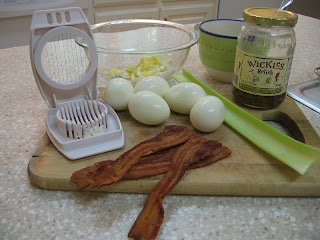I've been eating egg salad since I was a kid and love it. On occasion, I would order it at a deli or try some at a reunion spread and was always disappointed. How can you make egg salad without BACON? If you have never (I'm so sorry) had egg salad without bacon, make up some of this right away and have it on toasted wheat bread. You can thank me later!
But first we need to boil some eggs. I have long gone by the 15 minute rule but found a site on Pinterest that had even better hints. I tried it and it worked great:
~ Place eggs in heavy saucepan and cover with cold water.
~ Bring to a roiling boil.
~ Cover, turn off heat and set timer for 15 minutes.
~ Pour off hot water and cover in ice water (I put in sink and cover with ice and add water). If all the ice melts, add more) for 15 minutes.
~ Put eggs back in heavy pan, cover and SHAKE. Keep shaking...side to side and up and down.
~ The eggs should now be cover in lots of tiny cracks and the shells with come right off!
Recipe:
1 dozen boiled eggs, peeled & diced
8 slices of bacon, cooked crisp & crumbled (don't even think of using bacon bits!)
2/3 cup celery, finely diced (about 2 med sticks)
1 Tbls Wickles pickle relish (or sweet relish)
1 cup mayo
1Tbls cider vinegar
1 pkt sweetener (or 2 tsp sugar)
1 tsp mustard
salt & pepper to taste
In a large bowl, mix together the eggs and first three ingredients. Combine the mayo and last ingredients for the dressing and mix in with the salad. Chill for at least four hours (overnight even better) and serve on toasted bread or with crackers on a bed of lettuce.




















